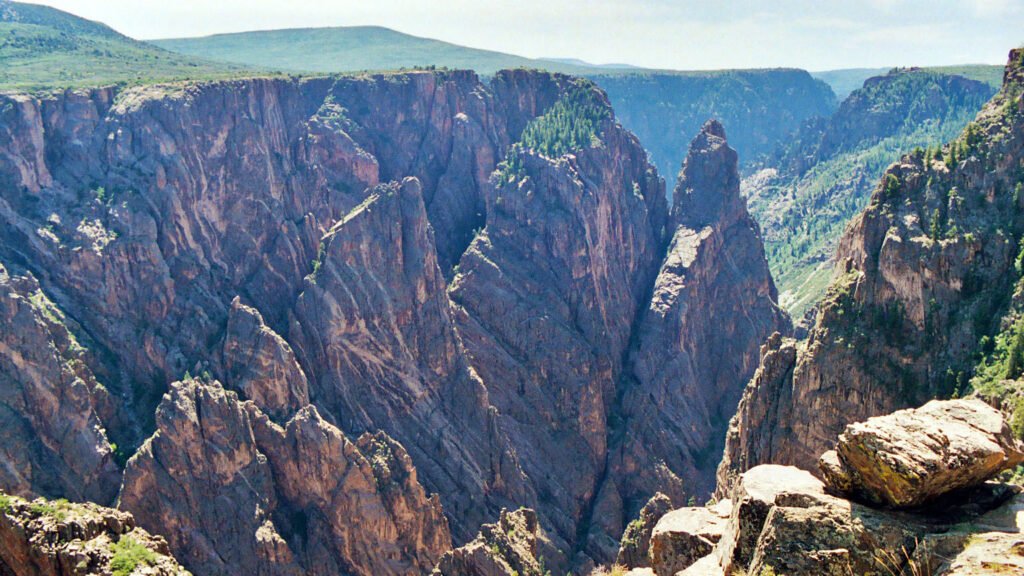Explore the stunning Black Canyon of the Gunnison National Park in Colorado. Discover its history, biodiversity, famous attractions, activities, accommodations, weather conditions, visitor information, conservation efforts, and travel tips.
Table of Contents
Introduction to the Park
Black Canyon of the Gunnison National Park, located in western Colorado, is a breathtaking landscape characterized by its sheer cliffs, dramatic rock formations, and deep, narrow gorges. The park encompasses over 30,000 acres, offering visitors a chance to experience some of the most awe-inspiring natural scenery in the United States. Designated as a national park in 1999, Black Canyon provides a range of recreational activities and opportunities for wildlife viewing amidst its rugged terrain.
History and Background
The history of Black Canyon of the Gunnison dates back millions of years, with the Gunnison River carving through the Precambrian rock to create the canyon’s striking features. The area was originally inhabited by the Ute people, who revered the canyon for its formidable beauty. European explorers and settlers arrived in the late 19th century, with the first recorded exploration of the canyon by John W. Gunnison in 1853. Over time, the canyon’s unique geological and ecological significance led to its protection and eventual designation as a national park.
Biodiversity
Black Canyon of the Gunnison is home to a diverse array of flora and fauna. The park’s varying elevations and microclimates support a wide range of plant life, from pinyon pines and junipers at lower elevations to Douglas fir and aspen higher up. Wildlife enthusiasts can spot mule deer, elk, mountain lions, and black bears, as well as numerous bird species including peregrine falcons, golden eagles, and canyon wrens. The Gunnison River itself is a haven for various fish species, making it a popular spot for anglers.
Famous Attractions
One of the park’s most famous attractions is the Painted Wall, the tallest cliff in Colorado, rising 2,250 feet above the Gunnison River. The North Rim and South Rim drives offer stunning overlooks, each providing unique perspectives of the canyon. Highlights include Gunnison Point, Chasm View, and Sunset View. For those seeking adventure, the Inner Canyon routes offer challenging hikes and rock climbing opportunities. The historic East Portal Road, which descends to the Gunnison River, offers a fascinating glimpse into the park’s geological history.
Activities
Visitors to Black Canyon of the Gunnison National Park can engage in a variety of activities. Hiking is a popular pastime, with trails ranging from easy rim walks to strenuous inner canyon hikes. The Rim Rock Trail and Warner Point Nature Trail are excellent options for scenic views. For those interested in fishing, the Gunnison River is renowned for its Gold Medal waters, teeming with trout. The park also offers opportunities for rock climbing, kayaking, and wildlife photography. In winter, snowshoeing and cross-country skiing provide a unique way to explore the park’s snowy landscapes.
Accommodations
While there are no lodges or hotels within Black Canyon of the Gunnison National Park, several campgrounds provide rustic accommodations. The South Rim Campground is the largest, offering sites for tents and RVs with some amenities such as potable water and restrooms. The North Rim Campground provides a more secluded experience with fewer facilities. For those seeking more comfort, the nearby towns of Montrose and Gunnison offer a variety of hotels, motels, and bed-and-breakfasts, catering to different budgets and preferences.
Weather Conditions
The weather in Black Canyon of the Gunnison varies significantly with the seasons. Summers are typically warm and dry, with temperatures ranging from 60°F to 90°F, making it an ideal time for hiking and camping. Spring and fall bring milder temperatures and fewer crowds, while winter can be cold, with temperatures often dropping below freezing and snowfall transforming the landscape into a winter wonderland. Visitors should be prepared for rapid weather changes and always check current conditions before their visit.
Visitor Information
Black Canyon of the Gunnison National Park is accessible year-round, with the South Rim being open throughout the year and the North Rim generally accessible from mid-April through mid-November, depending on weather conditions. The South Rim Visitor Center offers exhibits, information, and interpretive programs to enhance the visitor experience. Entrance fees are required, with options for annual passes. Visitors are encouraged to check the National Park Service website for up-to-date information on road conditions, trail closures, and special events.
Conservation Efforts
Conservation is a key focus at Black Canyon of the Gunnison National Park. The park’s unique ecosystem and geological features are protected through various initiatives aimed at preserving its natural and cultural resources. Efforts include habitat restoration, invasive species management, and educational programs to raise awareness about the importance of conservation. Visitors are encouraged to practice Leave No Trace principles to help protect the park’s pristine environment for future generations.
Tips
- Plan Ahead: Check the park’s website for current conditions and closures.
- Stay Hydrated: Bring plenty of water, especially during summer hikes.
- Be Prepared: Dress in layers and be ready for sudden weather changes.
- Respect Wildlife: Keep a safe distance from animals and do not feed them.
- Leave No Trace: Pack out all trash and respect the natural environment.
- Explore Both Rims: Each rim offers unique views and experiences, so try to visit both if time allows.
For more information, Click here to visit the official website.
Black Canyon of the Gunnison National Park is a hidden gem in Colorado, offering breathtaking landscapes, diverse wildlife, and a variety of recreational activities. Whether you’re hiking along the rim, descending into the canyon, or simply enjoying the views, the park provides an unforgettable experience. With careful planning and respect for the natural environment, visitors can enjoy all that this magnificent park has to offer while contributing to its preservation for future generations. Plan your visit today and discover the wonders of Black Canyon of the Gunnison National Park.
You may also like DISCOVERING NATURE’S MASTERPIECES: A GUIDE TO ARCHES NATIONAL PARK, UTAH

